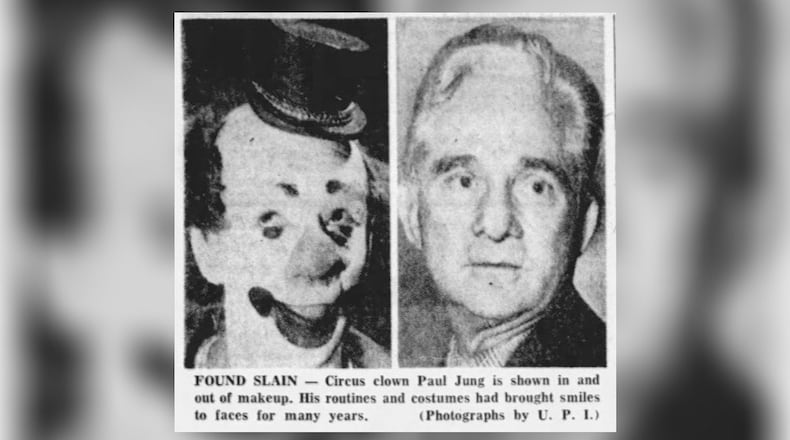Paul Jung, a circus clown who entertained millions of people during his nearly half-century career and whose face adorned Kellogg’s Sugar Smacks cereal boxes in the 1950s, grew up in Dayton before he met a tragic end in a New York City murder.
Born into a show business family on March 18, 1900, it didn’t take long for Jung to take to the stage. At age 8, he started performing acrobatic dancing and singing at the circus and on the vaudeville circuit.
He joined the Ringling Bros. Circus in 1917, when he was 17 years old. By 1934, he was the chief clown, a position he held for 25 years.
Paul’s brother, Walter Jung, was also a circus clown. A Dayton Daily News article written about them in 1919 previewed that the circus was scheduled to make a stop in Dayton. Along with being in the circus together, the two also did vaudeville and comedy motion pictures and were known for their “comedy acrobatic and knockabout act of four people.”
The brothers were in South America for several years and rejoined Ringling in 1908. At the conclusion of the 1919 season, the brothers were scheduled to leave for a tour of India, China and Japan.
When he achieved notoriety as an acrobatic clown, Jung said, “I guess that was when I really found what I wanted to do for the rest of my life.”
Jung became a highly paid circus performer and was known as a “producing clown,” one that created acts and produced props which other clowns used in routines.
Jung met his wife, Elsie, an equestrian and aerialist, while working with the Ringling-owned Hagenbeck-Wallace Circus in the early 1930s.
Eight months of the year they were on the road with Ringling Bros. and Barnum & Bailey. During the offseason, they enjoyed being at their house in Tampa, Fla.
In Tampa, Jung and his wife ran what he called a “Laugh Factory,” a successful shop that sold costumes and props.
In a 1952 Dayton Daily News article, Jung said, “We always try to make the act topical. The main thing is you’ve got to keep it simple, and the clown always has to get the worst of it in the end.”
“The reason we all stay on with the circus, I guess, is that there’s no thrill on earth like that first big, roaring laugh from the audience on opening night if the act is good,” he said.
In 1953, Jung appeared as a mascot for Kellogg’s Sugar Smacks cereal. His image could be found on cereal boxes over the next few years.
Jung’s life ended in tragedy. On April 21, 1965, during Ringling Bros. and Barnum & Bailey’s engagement at Madison Square Garden in New York, he was found murdered in his hotel room.
Allen Jones and his girlfriend, Marian DeBerry, both drug addicts, were charged with the homicide.
Jung was with the woman in his room, and she later testified she let in her boyfriend, who killed him.
Jung was robbed of $40 and a typewriter. The typewriter was found in a pawn shop, which led to the arrest of the couple.
DeBerry spent more than two years in the Women’s House of Detention before a judge sentenced her to time served and she was released. Jones was sentenced to life in prison. DeBerry was the star witness against Jones.
In his last performance, only hours before his death, Jung had worn his blinking neon eyeglasses and an ill-fitting orange and red coat.
The 1965 article reporting his death read: “It was a tragic end for the good-humored funnyman who made a career — and a fortune — making three generations of Americans laugh.”
Elsie kept the “Laugh Factory” business going into the 1970s, renting its collection of props to various shows.
In 1992,
Jung was inducted into the International Clown Hall of Fame.
About the Author





